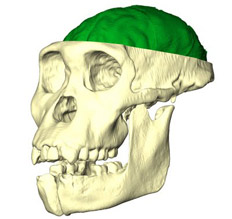Research
September 12, 2011
Hominid skull hints at later brain evolution

An endocast of the A. sediba skull was created using synchrotron radiation, giving scientists a high-resolution, 3-D view of life 2 million years ago. (Photo courtesy of Kristian Carlson/University of the Witwatersrand)
An analysis of a skull from the most complete early hominid fossils ever found suggests that the large and complex human brain may have evolved more rapidly than previously realized, and at a later time than some other human characteristics.
While some features of Australopithecus sediba were more human-like, most notably the precision-grip hand, the brain was more ape-like, says Emory University anthropologist Dietrich Stout. "It's basically a primitive brain that looks a lot like other austrolopiths, although you can see what could be the first glimmerings of a reorganization to a more human pattern."
Stout is a member of the team that analyzed a virtual endocast of the skull, which dates back nearly 2 million years, to the pivotal period when the human family emerged. The resulting paper will be among those on A. sediba appearing in a special issue of Science on Sept. 9.
If A. sediba is a human ancestor, as some have proposed, then its fossils could help resolve long-standing debates about human brain evolution, Stout says.
"The brain defines humanity, leading early anthropologists to expect that the brain changed first, and then the rest of the body followed," Stout says. "More recently, it has been assumed that the brain and other human traits evolved together."
The A. sediba find suggests a more "mosaic" pattern of evolution, he says. "The more modern hand paired with a primitive brain is a cautionary tale for what inferences can be drawn about a whole body from fossil fragments."
The new species was discovered in a region of South Africa known as the Cradle of Humanity, by paleontologist Lee Berger of University of the Witwatersrand (Wits) in Johannesburg. After announcing the find in 2010, Berger and colleagues began making the case that A. sediba may be the bridge between more primitive austropiths and the human genus, Homo. The debate over whether A. sediba is a human ancestor will likely continue, even as more material is excavated from a limestone cave called Malapa, one of the richest hominid fossil sites ever found.
"The site is especially exciting because the A. sediba skeletons are nearly complete," Stout says. "We can relate the face to the hand and the body and the brain of a single individual. A. sediba is represented by the most complete hominid skeletons we have, until we get up to the Neanderthals."
Stout studies the relationship between stone tools and brain evolution, and is an expert in functional adaptation of neuroanatomy. He was invited to assist in the analysis of the cranium of a young A. sediba male, estimated to be 12 to 13 years old at the time of death, with brain growth essentially complete. The research was led by Kristian Carlson of Wits and also included other researchers from Wits; Indiana University; the Georgian National Museum of Tibilisi, Georgia; the University of Zurich; Texas A&M University; and the European Synchroton Radiation Facility.
The virtual endocast gives a three-dimensional view of the surface features of the cranium, which was missing only part of the right side and the back. The high-resolution images reveal bumps and ridges and even impressions from blood vessels.
"You can actually see the morphology of the brain inside a skull," Stout says. "Bone is a lot more alive and plastic than many people realize. It's constantly being remodeled and shaped and the growing brain does a lot to shape the skull around it."
The researchers estimate that the brain was 420 cubic centimeters, around the size of a grapefruit. "That's tiny and about what you'd expect for a chimpanzee," Stout says.
The face, however, of A. sediba was far less protruded than that of a chimpanzee. "We don't fully understand how the human face got smaller and tucked under the brain case, although that may have a lot to do with diet and chewing," Stout says. "That further complicates matters. The relationship of human brain evolution to cognitive changes and other biological and behavioral changes is something we have to keep looking at."
The researchers took a band of measurements on the underside of the A. sediba frontal lobes and did a comparative analysis with humans, chimpanzees and other hominids.
While the A. sediba brain clearly was not a human configuration, a surface bump shows possible foreshadowing of Broca's area, a region of the human brain associated with speech and language, Stout says. "It's a big leap, however, to go from a surface bump to really understanding what the cells were doing beneath it," he adds.
The researchers plan to expand the analysis, gathering data from more scans of chimpanzee skulls and more hominid fossil specimens from East and South Africa. "We want to put as many dots on a comparative graph as we can, to help show us where A. sediba fits in," Stout says.
Use of simple stone tools by hominids began about 2.5 million years ago. Was A. sediba a toolmaker? Its hands appear associated with that activity, Stout says, but the evidence is still incomplete. "For now, A. sediba raises more questions than it answers."
